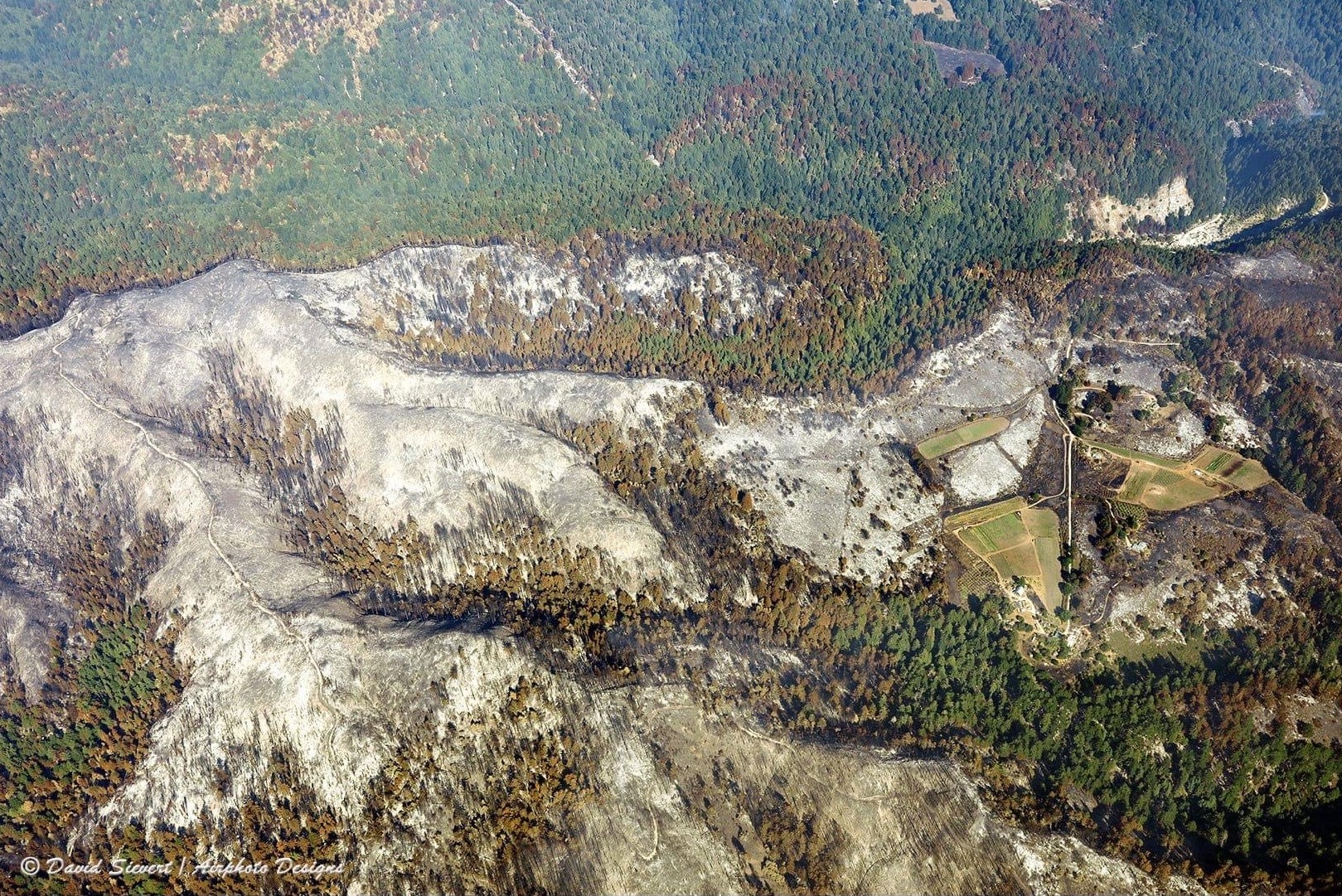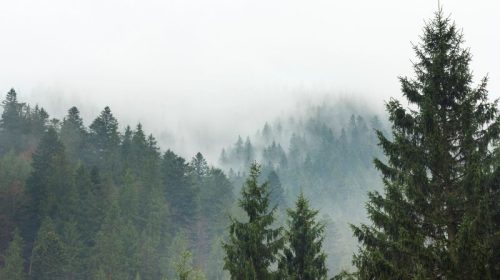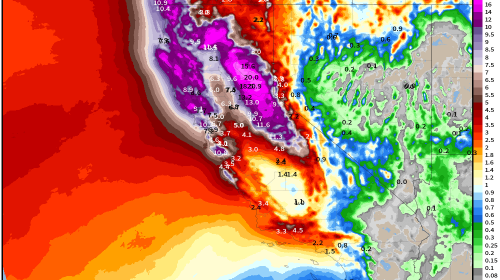Molino Creek Farms
By Dr. Grey F. Hayes
A Look Back…the Fire Timeline
Days before – a long, long heat wave! 94F or higher at the farm for several days, then….
Sunday August 16
2 am LIGHTNING! What a show!! Sheets of netted lightning all across the sky with a rolling ongoing thunder like the biggest timpani crescendo any sane orchestra has ever performed. Then a roll cloud, aka derecho, aka arcus cloud. The sudden appearance of a silvery cloud on the horizon, lit by the constant lightning. It filled a quarter of the sky then struck 70+MPH blast and high winds. Metal yard furniture moved from front to side yard. Branches broken, mayhem.
4:45 am SMOKE!! Whole toasted tanoak leaves and burnt stuff landing everywhere. Clothes on, boots and all – quick into the truck, drive to neighbor’s with horn blaring “FIRE!!”
“Calm down”, says one neighbor, “it’s not close.”
8/16 11 am photo of the smoke plume over the tomatoes – looking south towards the fire
We prepare all day for the fire. Fire hoses set out, go packs into cars, wetting down all surfaces, well pumping tanks full. We learn of the Warnella Fire, at our doorstep – just a mile or so as the junco flies between us and Davenport – on the walls of San Vicente Canyon below the quarry. We think that’s the threat.
Monday August 17
Warnella Fire is limited to 40 acres or so. Rumors of many other small fires.
Tuesday August 18
Fires around us grew overnight to a hundred or more acres each: 4 fires, Waddell and the ones up in Gazos Creek a bit bigger. We return to fire preparedness work. Giant loads of vegetation going to remote piles, away from infrastructure.
9/18 6 pm smoke abounds
Evening falls and I snap this photo of the smoke coming from NORTH! What’s going on up there?? We thought the threat was from the South??!!
Went to bed very uneasy. Few of us slept much.
Wednesday August 19
Full tilt boogie from first thing in the morning; fire tracking news shows that the once separate fires grew from 1200 to a single conflagration of something like 15,000 acres overnight! Teams go to water tank complexes to assure they are clear of debris; they work until they can work no more…leaving one tank complex incomplete (it later burns).
People clear around their homes, remove needles from rooftops. Loads and loads of vegetation hauled from everywhere: our brush piles were never so big.
2 pm Mike Chiodoni, Battalion Chief for the Bureau of Land Management, our near neighbors, come to the farm for a briefing. “If the shit hits the fan,” he says, “just get into the middle of your fields, you’ll be safe.” He says he’ll be back to give an update if anything more develops (but never comes back). One by one people evacuate- the smoke is too much!
9/19 4 pm sky that fateful day. It had been so dark from smoke you needed to turn on lights in the house at 2 pm.
7:30 pm, last person leaves Molino, except me. I pull fire hose out, change clothes to fire clothes, mask, gloves. Loud exploding trees, roaring approaching fire noise. Utterly terrified.
7:42 pm, fire roars onto the farm from the north. Moving sprinklers, wetting the yard.
9:00 pm, fire barrels into the yard, everything starts exploding in flames, terrified again but adrenaline pumping. Hauling fire hose from one wall of flames to the next, putting out spot fires in between. Have to suck down close to the soil, create a pocket of fine water for protection, back up, keep from getting too hot…protect the house and self.
9:15 pm, Bob Frank appears like an angel in the night, helps put out remaining spot fires around house. He and I are the only ones all night fighting fire, together – no professional firefighting support!
We wait for the fire storm to subside in our little safe envelope of post-fire steaming char. Then up to neighbor’s house, put out flaming plastic table, flaming rags…with seaweed extract and a hoe – hard to find water in the haste; hoses seem dry…assume tanks have burned up. Bob stays and keeps putting out spot fires (finds a working hose), I return home for more fire control.
August 20
Until 2 am we do what we can, moving hoses, hauling hoses, connecting more hoses, turning water on and off so as not to drain tanks, conserving water and using water. Dousing huge flaming trees and creeping grass fires, urging the longest jets of fire hose water towards too distant flames up against buildings. Protecting the barn, putting out fires next to our chickens.
In the rotation between fires, we think we’d protected one house, but we return to find it in flames. Rushing through it to gather what seems like valuable things that aren’t too deep in the smoke. Smoke alarms ring until the house collapses. Then, finally, it is safe to go still further afield to other neighbors, one more house gone, in ashes already, others okay.
We are both soaked and tired. Our bodies no longer able to operate. My hands were cramped such that gripping wasn’t possible anymore. Bob said his legs might collapse. I return home to cry for 2 hours as loud as I ever have.
Back up at 6 am…the work continued for days and days…
August 21, land still smoking, bad air…assessing damage: tomatoes survived!
August 25, evening
Assessing damage – finally getting to the orchard, couldn’t bear to look before…it lives! Scorched, crop lost, but growth buds swelling to replace lost leaves. First flowers coming out like its spring.
All around us, the landscape is burned. Here’s an aerial image – Molino Creek Farm is the green spot on the right, at the end of the gun barrel of raging fire – now ash.
We have lost a lot of rabbits, woodrats, songbirds. The swallows left the farm. The areas we spared from fire are packed thick with refugee rabbits, woodrats, harvest mice and the like.
Our tomatoes and other fleshy annual crops survived. Our orchards lost a bit: 23 of our 50 cherry trees are toast. 18 of the oldest of our 50 avocado trees probably won’t make it. Most of the apples will probably recover. Almost all of our orchard irrigation melted.
This is a setback, but we will survive. The outpouring of love and generosity humbles us all. We are so very grateful for our extended community.
Now, today, was our first fresh air morning. It is the “smoking holes” stage of the wildfire: underground root systems burn away where the stumps of trees once rested – smoking like lil’ volcanoes. If you wanted to roast some beets in the woods, many opportunities. The cost of that opportunity might be crushing: trees falling everywhere, once an hour, big crashing messes.
The raptors are having a field day: no cover for the prey. Cooper’s hawks getting chubby. Great horned owls so full they can hardly hoot.
Us humans scuttle to patch things up with the limited time we have: part of a fence propped up, melted parts of the water system repaired, generators and other equipment needs extra tinkering from heat/smoke damage, juggling a more limited water storage system, monitoring smoldering and falling trees, cleaning up. Paperwork.
The landscape surrounding the surreally green farm is blackened. It is black and gray, like dirty snow. Towering trees: big black skeletons. Acres of white ash where coyote bush recently teemed with wrentits and thrashers. Everything smells of fresh fire, even like a cheery campfire as it’s still burning.
Dr. Grey Hayes, co-owner and manager at Molino Creek Farm, has long focused on improving the understanding of agro-ecology and natural systems ecology along the Central Coast. When not doing research or coordinating research and education at Swanton Pacific Ranch, Grey likes farming, nurturing intentional community, and hiking. He strongly believes that a better functioning democracy will restore the Earth’s ecological vitality, providing for long term human health and happiness.
Molino Creek Farming Collective comprises 137 acres and was founded by several families
to preserve family farming and the beauty and exquisiteness of the land.
Read the Molino Creek Blog at https://molinocreek.wordpress.com/
Photos contributed by Dr. Grey F. Hayes
The San Lorenzo Valley Post is your essential guide to life in the Santa Cruz Mountains. We're dedicated to delivering the latest news, events, and stories that matter to our community. From local government to schools, from environmental issues to the arts, we're committed to providing comprehensive and unbiased coverage. We believe in the power of community journalism and strive to be a platform for diverse voices.






Hello,
I picked up some of your tomato sauce at the Boulder Creek Community Operation feed the people last Wednesday. I made sauce for my spaghetti dinner tonight. The sauce was amazing. Thank you so much.
Would like to get more👍